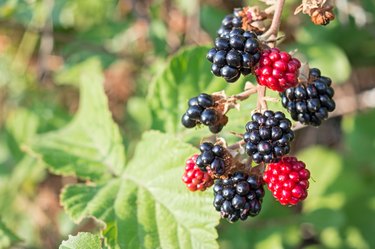
Wild blackberries grow in the western and eastern regions of the United States in warm climates. The blackberry is similar in appearance and related to the raspberry. When ripe, blackberries are dark purple and plump. Picking them in the wild is both a tempting and rewarding seasonal pastime, but there are some risks you should be aware of.
Nutrients in Blackberries
Video of the Day
Eat blackberries soon after picking them because the fruit is perishable. The berries are good for you, providing good amounts of antioxidants that protect the body's cells from free-radical damage. A 1-cup serving of blackberries contains 62 calories, making them a wise choice for anyone watching their diet. The Institutes of Medicine reports that women up to age 50 should have 25 grams of fiber per day, and over 50 should have 21 grams per day, while men up to 50 should have 38 grams and over 50 should have 30 grams. A 1-cup serving of raw blackberries contains 7.6 grams of fiber, which is almost 30 percent of the recommended daily intake for women, and roughly 21 percent of the RDI for men.
Video of the Day
Vitamins and Minerals
Blackberries are high in vitamins and minerals, with a 1-cup serving providing 30.2 grams of vitamin C, which is 40 percent of the RDI of 75 grams for women, and 30 percent of the RDI of 90 for men. Vitamin K content comes in at 28.5 micrograms, or roughly 30 percent of the RDI of 90 micrograms for women and 24 percent of the RDI of 120 micrograms for men. Vitamin K plays an important role in blood clotting, so if you are on blood thinning medication such as aspirin or warfarin, you should be cautious to not over-indulge on vitamin-K rich foods. Speak to your doctor regarding what your recommended daily intake of vitamin K should be.
The primary minerals in blackberries are manganese and copper. Manganese and copper are often used together to treat osteoporosis and weak bones, according to the National Institutes of Health. A 1-cup serving of blackberries contains 0.9 milligrams, which is 50 percent of the RDI of 1.8 for women and 40 percent of the 2.3 for men. Copper content is 200 micrograms, which is roughly 22 percent of the RDI of 890 to 900 micrograms for men and women.
Identify
When picking wild blackberries, the first step is finding them. Blackberries tend to grow along roads and the sides of rivers and streams, in open fields and occasionally in wooded areas. Blackberry bushes bloom with white and pink flowers in the spring, and the fruit ripens in mid- to late summer. The blackberry is a drupelet fruit that has a cluster of aggregate fruit pieces joined together to form each berry. No drupelet fruit is considered poisonous, according to the magazine "Mother Earth News." Be sure to use a field guild with photographs to identify the fruit before eating it.
Other Precautions
One danger in picking wild berries is when fruit has been recently sprayed with pesticides. Evidence of recent pesticide use is a clean line of dead vegetation on or near the blackberry bush. If the area looks like foliage died recently, find a different blackberry bush. Wild animals and wild blackberries are often found in the same locations. To avoid unpleasant and potentially dangerous encounters, make noise so animals will flee.
- National Gardening Association: Edible of the Month: Blackberries
- Mother Earth News: Tips for Picking Wild Berries
- Institutes of Medicine: Macronutrients
- Institutes of Medicine: Recommended Dietary Allowances and Adequate Intakes, Elements
- National Institutes of Health Medline Plus: Manganese
- National Institutes of Health Medline Plus: Copper
- USDA National Nutrient Database: Blackberries, Raw